Many credit the invention of the incandescent light bulb with Edison or Swan but its development actually took place over two centuries and by the time Edison and Swan got involved, the tech was down to the details. Those details, however, meant the difference between a laboratory curiosity that lasted minutes before burning out, and something that could be sold to consumers and last for months. Here then is the story of how the incandescent light bulb was invented.
The Laboratory Curiosity
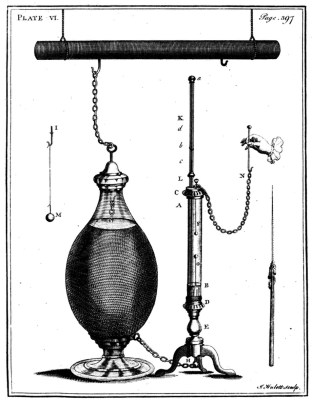
Our story starts in 1761 with Ebenezer Kinnersley. In a letter to Benjamin Franklin he described experiments he did for testing if heat was produced by electricity. His power sources were electrostatically charged capacitors made with a case of bottles, or Leyden jars, batteries not having been invented yet. To get sufficient current to detect a change in temperature he needed to release all the stored charge at once through a spark gap. In one experiment (Expt. 11 in the letter) the current was sufficient to make a brass wire turn red.
Today we say that the wire became incandescent, it emitted electromagnetic radiation in the form of visible light as a result of the heat. He also arranged the experiment such that the wire was suspended with a weight at its bottom and found that it elongated by an inch when it got red-hot, the first indication that such heating can be destructive to the wire. He experimented with different diameter wires all of the same material and found that the larger ones showed no noticeable heating effect and concluded that this was due to the lower resistance of the larger ones.
The next step came with the publication of the invention of the battery by Alessandro Volta in 1799. This made possible testing with a constant current. Many experimenters were very quick to expand and improve on the battery such that by 1802 Humphry Davy had access to a particularly large one consisting of 2000 cells in the basement of the Royal Institution of Great Britain. He produced light by passing current through thin strips of platinum, platinum having a sufficiently high resistance but also a high melting point. But it still didn’t last long and wasn’t very bright.
Over the next 75 years many either experimented with incandescent light or replicated the work of others. James Bowman Lindsay of Scotland wrote that in 1835 he’d done experiments in sealed glass jars and that air was not required, though it’s not clear if that meant only that the jars were sealed or that he evacuated them to some extent.
In 1838, Belgian Marcellin Jobard experimented with a vacuum and used a carbon filament. In 1840, Warren de la Rue used a platinum coil in an evacuated tube but the cost of the platinum made it not commercially viable. The first patent for an incandescent light went to Frederick de Moleyens of England in 1841 for using platinum wires in a vacuum bulb, though he also experimented with carbon.
An American, John W. Starr, received British patent 10,919 in 1845 under the name of his business associate King for two types of light bulbs, one with platinum but not in a vacuum. The other used carbon filaments in a Torricellian vacuum, which produces a pressure of 10^-3 torr (1.3×10-6 atm). Starr died shortly thereafter and so did not pursue it commercially.
In 1872, Russian Alexander Lodygin (or Lodyguine) applied for, and was later granted a Russian patent for his incandescent light. The light used two carbon filaments, only one of which was in use at a time. When the first filament burnt out, an external commutator could be rotated to put the other into use. He at first filled it with nitrogen and then switched to a vacuum. In 1873 and 1874 he experimented with lighting on ships and for city streets and formed the Electric Lighting Company, A.N. Lodygin and Co. But he became involved with socialist ideas and eventually had to leave Russia.
There were many other inventors leading up to and including the 1870s but none produced bulbs whose filaments lasted long enough to be commercially viable, many of them introducing techniques such as Lodygin had, putting more filament into play as it was consumed.
Into Consumer’s Hands
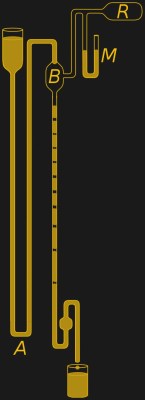
It’s hard to say if there was any aha moment that finally lead to a commercially viable light bulb, though if there were big contributors they were probably the Sprengel mercury vacuum pump, invented in 1865, allowing a higher vacuum, and longer lasting power sources.
Joseph Swan, a British chemist and physicist, did experiments in the 1850s and 1860s but gave up for those two reasons, an inadequate vacuum and shortage of power. But with the invention of the Sprengel vacuum pump, Swan started up again in the 1870s and by 1878 was able to develop a bulb that didn’t blacken inside. It was granted a British patent in 1880. That bulb used a thick carbon filament from arc lamps and lasted 40 hours. However, the low resistance meant it needed high current and thick wires to feed it, making it not commercially viable.
He then experimented with “parchmentised” cotton thread, treated with sulphuric acid. It had the appearance of metal, was strong, durable and at 0.01 inches in diameter could be formed into a 1/10th of an inch spirals. With 100 volts it provided an output of 60 candle power. He obtained another patent on November 27, 1880.
At this point he began lighting places, starting with his house and powering it with hydroelectricity, the first house in the world lit with electric light. After starting his company, the Swan Electric Light Company Ltd., that was followed by other dwellings and landmarks, including the Savoy Theatre with 1200 lights as well as the Law Courts in London.
However, there were still problems with the cotton filament including that any variation in thickness caused uneven heating, making it useless. He found a solution to this by removing the nitrous from nitro-cellulose (cotton is almost pure cellulose), dissolving the cellulose and extruding it as a very fine thread. This he also patented.
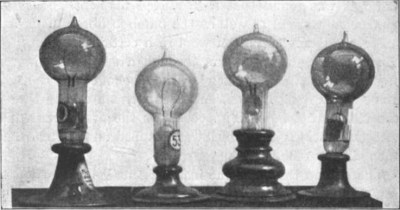
Independently of Swan, in 1878 Thomas Edison also began experimenting with incandescent lighting, applying for his first lighting patent and forming the Edison Electric Light Company that same year. He too used the Sprengel vacuum pump. He worked with both carbon filaments and platinum but settled on carbon. His first success on October 22, 1879 lasted 13.5 hours. After working on it further, he filed his most famous lighting patent on November 4, 1879 and the patent was granted in 1880. It was after this that Edison and his team realized that a carbonized bamboo filament light lasted 1200 hours. It was also in 1880 that Edison lights were installed for the first time outside of Edison’s laboratory on the SS Columbia, a cargo and passenger steamship.
Unlike Swan, who powered lights with generators dedicated to the locations where they were used, Edison was installing electric generating stations for whole neighborhoods. As such he had both a long-lasting incandescent light and the means to power them continuously.
As you’d expect, Edison had patent disputes, perhaps the best known one regarding William Sawyer, who had similar patents from 1877 and 1878, predating Edison’s. But Sawyer never managed to make a lasting light and the dispute was eventually settled in Edison’s favor. Edison avoided a patent dispute with Swan in Britain by merging the British Edison Company with Swan’s in 1883 to form the Edison and Swan Electric Light Company, commonly known as Ediswan. Another well known patent that Edison bought out was that of Canadian inventors Henry Woodward and Mathew Evans who, in 1874, were granted a patent for their bulb which used carbon in a rarefied gas-filled glass tube, the gas being nitrogen.
The Light Bulb We Know (Or Knew)
Alexander Lodygin, whom we mentioned above from 1872 and who had to leave Russia, didn’t stop experimenting at that time. He was granted a few US incandescent light patents starting in 1886 and also had patents in France, Germany, England and Belgium. In the 1890s he experimented with metallic filaments and is said by some to be the first to use tungsten filaments. Tungsten filament lights were brighter and lasted longer than carbon filament lights.
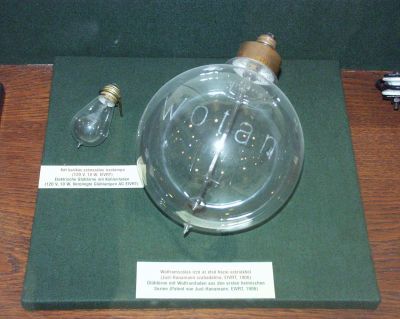
Regarding the use of inert gas in the bulb instead of a vacuum, we’d mentioned above that Alexander Lodygin, and Woodward and Evans had experimented with filling bulbs with nitrogen. However, it was Irving Langmuir in 1913 who discovered that by filling a tungsten filament light bulb with an inert gas such as argon, the lifetime of the tungsten filament could be lengthened significantly. And in 1930 Hungarian Imre Bródy designed a way to get krypton from air and thereby first replaced the argon with krypton.
 In 1917, Burnie Lee Benbow found a way to manufacture coils of coiled tungsten filament and in 1921 Junichi Miura, while working for Hakunetsusha,a predecessor of Toshiba, created the first bulbs using the coiled coil filaments.
In 1917, Burnie Lee Benbow found a way to manufacture coils of coiled tungsten filament and in 1921 Junichi Miura, while working for Hakunetsusha,a predecessor of Toshiba, created the first bulbs using the coiled coil filaments.
Finally, in 1924 American chemist Marvin Pipkin patented frosting the interior of the bulb without weakening it and in 1947 he patented coating the interior with silica giving us the bulbs that give off a more diffuse light that many of grew up with.
End Of Story
And so to answer the question, who invented the light bulb, all of the above did along with a few more, though those are the highlights.
However, that doesn’t mean there isn’t still room for us hackers. Check out this DIY incandescent light made using a Dom Perignon champagne bottle or this CO2 filled one in a jar. It’s nice to see in this age of CFL and LED light bulbs that there’s still a glimmer of light left in the story of the bulb that first so brightened our lives.

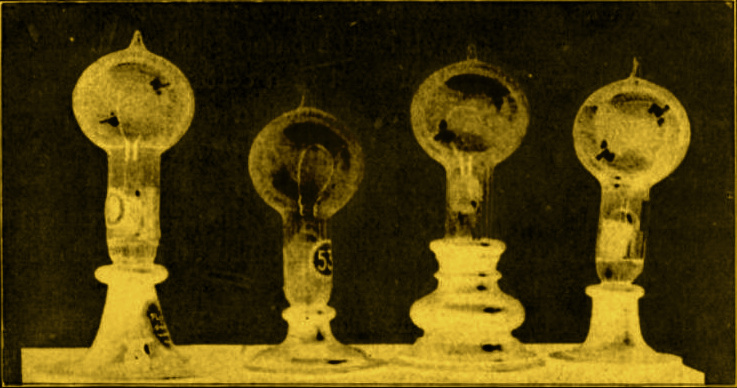















And here you can read why incandescent light bulbs only last for 1000 hours:
http://spectrum.ieee.org/geek-life/history/the-great-lightbulb-conspiracy
Oh, for Pete’s sake. The conspiracy theorists need to up their game. A 2500-hour bulb burns dimmer, less efficiently, so costs more in power, and requires more generator plant infrastructure for a given number of sockets or lumens delivered. A brighter, more efficient bulb will cost less per lumen-hour of light, have lower total cost of ownership, and more people can be served with a given amount of power available. A win-win over all, even if you have to replace the bulb more often. The “secret conspiracy” that the tinfoil hatters delight in rediscovering every few years was nothing more than industry standardization and quality control improvement.
At todays prices for electricity that would make sense. But back then the cost of two and a half bulbs vs. the electricity used to light a slightly less efficient bulb does not stack up.
back then electricity was extremely expensive, you might have confused the political propaganda of some modern factions with that of reality, electricity had a very bad infrastructure, with huge losses, generation was inefficient and unreliable, electricity might very well have been worth 5 bulbs, that is a guess but it does illustrate the point i am trying to make.
I can find some quotes saying 1910 electricity prices were 10-20 cents a kWh which in today’s money is around $3.50 a kWh.
Running a single 40 Watt bulb 8 hours a day would cost you the equivalent of $8 a week.
https://fraser.stlouisfed.org/scribd/?title_id=4172&filepath=/files/docs/publications/bls/bls_0664_1939.pdf
In 1925 it was 7.20 cents per kWh equivalent to 97 cents a kWh today, so a 60 Watt bulb would have consumed 60 dollars worth over 1000 hours and $120 over 2000 hours.
The price of a bulb would be around $5-7
The less efficient bulbs that lasts twice as long would save you $5-7 but assuming you lose 10% more energy, would cost you $12 more over 2000 hours. Of course, that is assuming you notice the difference. You could use a dimmer bulb of equal wattage, and that is what happened as people did not have the means to measure the brightness of bulbs.
The result was that people preferred the dimmer bulbs as they cost less to run, and so manufacturers were competing in who makes the dimmest bulb that lasts the longest, and the whole advantage of the tungsten filament bulb was being lost as cheaper tantalum filament bulbs could also burn very long at such low brightness levels.
The life span of incandescent bulbs was partly due to engineering compromises made to operate the filament hot enough to approximate sun light and gas mantel lamps vs efficiency.
… and with that document I’ve learned a new word: Patentgemeinschaft.
The Germans are more clued up to the real purpose of patent pools then I give them credit for!
And of course the centennial light bulb http://www.centennialbulb.org/
The cartel was formed because of the brightness/life compromize in bulbs: the public could not measure or compare the brightness of lightbulbs because the human eye is crap at absolute luminosity measurement, so the only point of comparison they had was the lifetime of the bulb.
Cheaters made dimmer bulbs that consumed more energy, which made it a race to the bottom: if they hadn’t standardized to 1000 hours then people would end up buying the least efficient bulbs and making good lightbulbs would have been pointless.
It’s curious how when the industry self-regulates in this way it’s called corruption and conspiracy, but when the government mandates an energy efficiency standard it’s called progress.
Calls it a ‘race to the bottom’ then wonders why /not/ doing that is called progress.
You didn’t quite get it.
The race to the bottom was before the cartel took hold and mandated a maximum lifespan to increase bulb efficiency. That’s because there’s an insurmountable physical link between the two features – if a manufacturer was found to make bulbs which lasted too long, they must have had done so at the expense of brighness and efficiency.
That is, the cartel was a fix to a declining situation, because the public couldn’t trust the manufacturers to make proper bulbs. The manufacturers tried to outbid each other by selling longer and longer lasting bulbs which came cheaper to the consumer but the quality and quantity of light became worse and the consumers could no longer trust that a 60 Watt bulb was as bright as another 60 Watt bulb.
The conspiracy theory was that it was possible to create a bulb that was both bright AND lasted 2,500+ hours, but the cartel deliberately made the bulbs so shoddy they would only burn 1,000 hours – but this was not true: an incandecent bulb’s brightness is inversely proportional to its lifespan: the hotter it runs the brighter it is, and the sooner it burns through.
If the govenrment had issued an efficiency standard, some sort of candle power per watts minimum, it would have had the exact same effect: the bulb lifespans would have dropped all across the board. This then would have been called “progress”, but since the industry decided to do it on their own, it was picked up as a case example of insidious corruption
o tempora o mores
There is a documentary about this built in obsolescence:
http://topdocumentaryfilms.com/light-bulb-conspiracy/
“Starr died shortly thereafter and so did not pursue it commercially.”
Having died is a pretty good reason to not pursue something commercially.
Well, perhaps he could have… perhaps a matter of willpower or perhaps he turned into a zombie (although nothing is mentioned about him being a zombie of some sort). Anyway, history has shown that zombies aren’t good businessman (because, well, how many do you know?). Though if he only tried, then he most likely would have been the first (and perhaps most successful) zombie entrepreneur.
Zombies don’t need light, they can smell brains.
How many zombies does it take to change a lightbulb?
Doesn’t stop Disney…
This is one of my favourite lines ever from Hackaday!
And there is a Wiki with more information:
http://conspiracy.wikia.com/wiki/Light_bulb_conspiracy
That was a nice rundown of the skilled persons whose contributions literally lit up the world. I have one question, though: Where does the work of an inventor named Lewis Latimer fit in? Latimer is widely credited with creating (or perfecting) the carbon filament that glowed within incandescent light bulbs in 1881. He also worked for Edison. Thanks!
If you want to see a Sprengel pump in action, Cody’s Lab of YouTube built one and shows off how it works. It’s a nifty little device. https://www.youtube.com/watch?v=viJ3T-1KZqY&ab_channel=Cody%27sLab
Nice! Thanks for that. An unexpected, pleasant side effect of writing this article was running across those old methods for making a vacuum.
+1, good watch
“In 1806, William D. Coolidge, while working for General Electric Company, found a way to make ductile tungsten…”
1906 I suspect.
Thanks. Fixed. I originally made that mistake for most of them when I got to the 1900s. Got stuck in the 1800s I guess.
We could have had the spectrally superior and far more efficient “Sulphur Lamp” in 1910 too, but everyone was busy copying each other and didn’t think of it.
https://en.wikipedia.org/wiki/Sulfur_lamp
https://en.wikipedia.org/wiki/Cavity_magnetron
https://www.youtube.com/watch?v=zTqrZyQdj6c
“Spectrally superior” is a dubious clam, considering the optimum spectrum of a lamp depends on how bright the room is where you’re using it. At low light levels the human perception of the red end of spectrum falls off pretty quickly, which is why when a room is fairly dimly lit by a regular 60 Watt equivalent or two, the color temperature should be low.
https://en.wikipedia.org/wiki/Kruithof_curve
There was a fad at one point to buy daylight (4000-7000K) CFL bulbs when they first became available, on the argument that the light was “superior and natural”, but in practical use they just killed your color perception and made all rooms look bleak and dreary, and messed up with peoples’ circadian rythms.
Except we are not talking about a dim light source at all and you could always down shift the light colour with a physical filter, such as a lamp shade. The point is that it is the full visible spectrum with little wasted on the ends where humans can’t see at all.
It’s not about the brightness of the light source, but about the brightness of the space that is being illuminated. You’re not looking at the lamp you know.
A sulfur plasma lamps are just too bright for living spaces. They don’t scale down very well, and they’re a massive source of radio interference due to the magnetron, and they’re technically not very efficient after you apply absorbing filters to the output.
Whatever Dax, they are useful and used. Do some research on current products.
Who said anything about absorbing filters, downshifting is an efficient quantum effect and it works well with LED enclosures that would otherwise have overly blue output. In fact you can use florescence to convert just the UV part to light at the red end to make the output warmer. Win-win.
RF is not a problem if you have a mirror grid and at worst that tiny area absorbs 5% or less of whatever small % it covers, the rest is reflected so it acts as a diffuser.
Are you arguing for the sake of it, or testing my knowledge?
>they are useful and used. Do some research on current products.
Yeah, if you need to light a stadium. They don’t come much smaller than 500 W.
Cragside House at Rothbury in Northumberland was the home of Lord Armstrong, who was a friend and patron of Joseph Swan (a Sunderland lad) and was the first house to use the combination of hydroelectric power and (Swan’s) incandescent bulbs for electric lighting (the light switches which we take for granted today were yet to be invented, so the ground floor lights and upper floor lights were on separate circuits, with the lights on each floor being either all on or all off at the same time).
Another innovationat Cragside was the storage of power in batteries during peaks in generation …the old becomes new again; eat your heart out Elon! :-)
Cragside is now owned by the national trust and is open to the public, with many of the original light fittings still in use, but equipped with LED lamps to run from a modern, much smaller hydroelectric plant.
Cragside was the the first house to be lit by *hydroelectric power*. Initially the Cragside lighting system was based on carbon-arc lamps, but they were found to be too bright, smokey and burned inconsistently and thus produced a lot of flicker and often needed the arc to be manually restruck during use. It was several years later (depending on sources), in either 1880 or 1886/7, that Lord Armstrong employed Swan to illuminate the house with his improved lamps. Certainly by 1887 it is recorded that 45 of swans lamps are installed at Cragside.
Also the “first light switch” was created and demonstrated in Newcastle-Upon-Tyne around 1879 by John Henry Holmes. Holmes attended a public demonstration of Joseph Swan’s incandescent lamp (most likely to have been Swans’s January 19th (Sunderland) or February (Newcastle) 1879 demonstrations) and became interested in the new field of invention. The demonstrated switch was an early prototype of his final switch design. The switch was first to employ the “fast make / break” design that is still common to modern switch gear. The switch is often cited as being made in 1884 or later, but there is some written evidence of his earlier demonstration around 1879 or 1880. There is much evidence that Holmes had approached Swan numerous times in regards to be his student or assistant, and even suggestion of business partner – all of which was declined by Swan. It has been claimed that Swan did employ Holmes at some point to create an improved version of his switch to use with the swan lamps, and this may be the 1884 version that is alluded to as being the “first”. The 1884 date may also be the date of the UK patent being granted, thus the switch actually made prior to this date.
In 1883 JH Holmes opens an electrical works at Portland Road Newcastle.
Interesting fact: In 1881 the “world’s first” Lamp factory was located in the Benwell area in Newcastle for the manufacture of Joseph Swan’s newly-patented electric lamps.
The HaD story is also somewhat incorrect – In 1880 Thomas Edison tried to take Joseph Swan to court (in the UK and USA) over an alleged infringement of patent in the development of a successful electrical light bulb. Edison made a number of public statements about swan “stealing” his work, and Swan had no choice but to counter sue, though he was reluctant to do so. but it becomes clear that the two inventors have coincidentally made their developments at the same time. Eventually both parties agree to create a shared ownership business in the UK (Swan had no real interest in pursuing the manufacturing of his lamps on his own, preferring to leave it to others).
1883 – EDISON-SWAN Company founded (TYNESIDE)
The Edison & Swan United Electric Light Company is formed. The American inventor Thomas Edison teamed up with Tyneside industrialist Swan. Edison retained sole ownership of USA patent and rights, and used the Swan Patent for the UK sales.
Swan is later forced out of this company, Edison takes over and continues to make huge profits from the UK company.
I was unaware of almost all of this, thanks for posting it, Steven! Great article.
Nice article, thank you Steven.
I’m making incandescent light bulbs for a 5 years now. Despite all the knowledge that we accumulated, each light bulb is unique, and there are still plenty of space to discover, invent and try something new. (technically or aesthetically)
It looks simple to make one from the side, but actually it’s a complex task, (if you want to make a good working one). You need a variety of knowledge which based on all inventions and discoveries of the great people that mentioned in a post… …My two cents :)
There are many others, which I think we should pay a respect, or just think about. Those guys who worked on vacuum glass-metal seals development, glass, filament heat circulation and bulb shapes, out-gassing processes, getters, later on tungsten metallurgy (to obtain non-sag and other types of filaments)… They are not worked directly on a light bulb, but without their inventions it would be impossible to make a good working light bulb.
Before the article get completely redacted from history.
http://www.abload.de/img/timiscgkvr.jpg
It’s even an outdoor public display. I know, I know “cool story bro” is what I expect from most folk.
Here you go http://www.timisoara-info.ro/en/sightseeing/historical-quarters/cetate/tours/224-felinarul.html. I’d say it’s an interesting story.
There’s surprisingly little information available about one key discovery with the carbon filaments, which is how they managed to “metallize” the carbon into graphite and who came up with it:
” Early carbon filaments had a negative temperature coefficient of resistance — as they got hotter, their electrical resistance decreased. This made the lamp sensitive to fluctuations in the power supply, since a small increase of voltage would cause the filament to heat up, reducing its resistance and causing it to draw even more power and heat even further. In the “flashing” process, carbon filaments were heated by current passing through them while in an evacuated vessel containing hydrocarbon vapor (usually gasoline). The carbon deposited on the filament by this treatment improved the uniformity and strength of filaments as well as their efficiency. A metallized or “graphitized” filament was first heated in a high-temperature oven before flashing and lamp assembly. This transformed the carbon into graphite which further strengthened and smoothed the filament. This also changed the filament to have a positive temperature coefficient, like a metallic conductor, and helped stabilize the lamp’s power consumption, temperature and light output against minor variations in supply voltage.”
That contribution may have been Lewis Latimer’s. As I posted above, I know he is widely associated with perfecting the carbon filament that was used.
Very interesting story. Edison had no interest in light bulbs except to supply an outlet for the power his electrical generating plants produced. Read a contemporary biography and you will find this stated emphatically. The factor causing his interest was that there was no available source of usable bulb at the time in this country. The story of Edison inventing the light bulb and not getting credit for his inventing half the “modern” telephone ( the carbon button found in the old desk telephone) is a part of the urban legends of science.